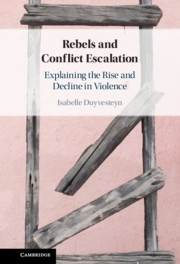Book contents
- Rebels and Conflict Escalation
- Rebels and Conflict Escalation
- Copyright page
- Dedication
- Contents
- Tables
- Vignettes
- Preface and Acknowledgements
- Abbreviations
- 1 Rebels and Escalation
- 2 Escalation and De-Escalation
- 3 Political Opportunity and Rebel Violence
- 4 Political Will
- 5 Capabilities
- 6 Capabilities
- 7 Political Will
- 8 Legitimacy and Support
- 9 De-Escalation
- 10 The Escalation and De-Escalation of Rebel Violence
- References
- Index
5 - Capabilities
Strategy
Published online by Cambridge University Press: 01 July 2021
- Rebels and Conflict Escalation
- Rebels and Conflict Escalation
- Copyright page
- Dedication
- Contents
- Tables
- Vignettes
- Preface and Acknowledgements
- Abbreviations
- 1 Rebels and Escalation
- 2 Escalation and De-Escalation
- 3 Political Opportunity and Rebel Violence
- 4 Political Will
- 5 Capabilities
- 6 Capabilities
- 7 Political Will
- 8 Legitimacy and Support
- 9 De-Escalation
- 10 The Escalation and De-Escalation of Rebel Violence
- References
- Index
Summary
Chapter five has as its central focus the strategies employed in conflict and their link to escalation. The chapter discusses the atrocity shift or the transgression of ethical boundaries as a major form of escalation. Furthermore, it assesses the strengths and weaknesses of the two predominant strategies of rebel groups, terrorism and insurgency.
- Type
- Chapter
- Information
- Rebels and Conflict EscalationExplaining the Rise and Decline in Violence, pp. 88 - 109Publisher: Cambridge University PressPrint publication year: 2021

